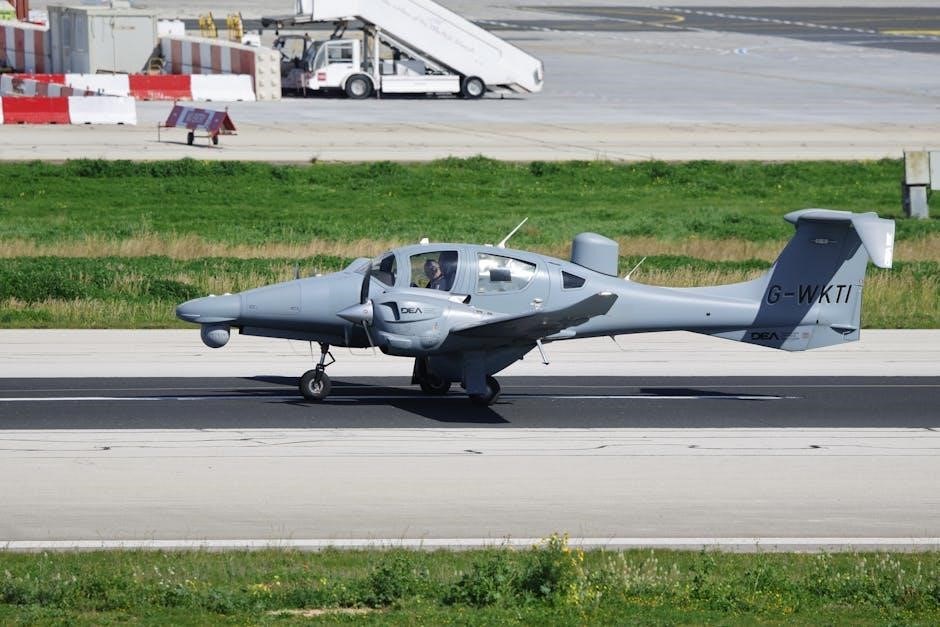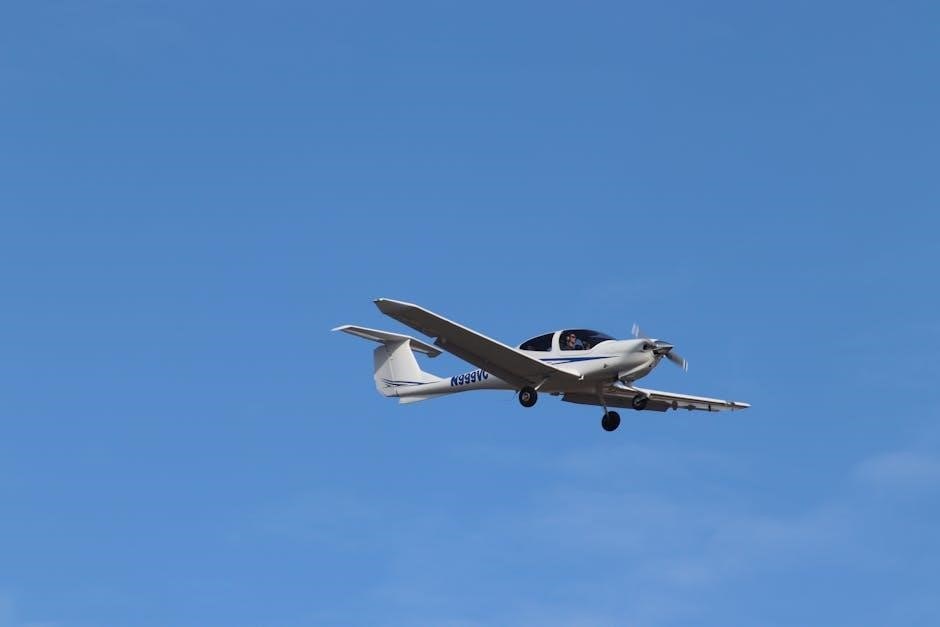The private pilot oral exam is a critical component of the checkride‚ assessing a pilot’s knowledge and decision-making skills. Proper preparation using study guides like the ASA Oral Exam Guide ensures readiness. Understanding FAA regulations‚ weather interpretation‚ aircraft systems‚ and emergency procedures is essential for success. This comprehensive evaluation requires a deep understanding of aviation principles and practical applications.
Overview of the Checkride Process
The checkride is the final step in obtaining a private pilot certificate‚ combining an oral exam and a practical flight test. The process begins with a review of documents‚ ensuring compliance with FAA requirements. The oral exam assesses knowledge of regulations‚ aircraft systems‚ weather‚ and emergency procedures. The flight test evaluates piloting skills and decision-making. Preparation is key‚ as the examiner verifies both aeronautical knowledge and safe flying practices. A comprehensive understanding of the ACS and FAA materials is essential for success in this rigorous evaluation;
Importance of Preparation
Preparation is critical for success in the private pilot oral exam. Thoroughly reviewing FAA materials‚ such as the ACS and FAR/AIM‚ ensures familiarity with key topics. Practicing with mock exams helps identify weak areas and builds confidence. A well-prepared candidate demonstrates competence and safety awareness‚ reducing exam anxiety and improving performance. Dedication to studying and understanding aviation principles is essential for passing the checkride and becoming a proficient pilot.

FAA Reference Materials
FAA reference materials like the FAR/AIM‚ PHAK‚ and ACS are essential for preparation. These documents provide critical information on regulations‚ weather‚ navigation‚ and aircraft systems‚ ensuring thorough readiness.
Essential Documents for the Oral Exam
The Airman Certification Standards (ACS) is the primary document for the oral exam‚ outlining required knowledge and skills. The FAR/AIM provides regulatory guidance‚ while the Pilot’s Handbook of Aeronautical Knowledge (PHAK) covers foundational concepts. Additionally‚ ensure you have your pilot certificate‚ medical certificate‚ and government-issued ID. Bring aircraft-specific documents like the POH and weight and balance report. Organized logbooks and recent flight logs are also recommended to demonstrate proficiency and preparedness for the examiner’s questions.
Understanding the Airman Certification Standards (ACS)
The Airman Certification Standards (ACS) outlines the knowledge‚ skills‚ and risk management strategies required for pilot certification. It organizes tasks into areas of operation and specific skills‚ with clear performance metrics. The ACS emphasizes scenario-based questions‚ ensuring practical application of knowledge. Pilots must study the ACS thoroughly‚ as it serves as the primary reference for the oral exam and practical test. Familiarity with its structure and content is crucial for demonstrating competence and meeting FAA expectations effectively.

Common Questions Asked During the Oral Exam
The oral exam covers a wide range of topics‚ including aircraft performance‚ weather interpretation‚ navigation‚ regulations‚ and emergency procedures. Thorough preparation and practical knowledge are essential for success.
Aircraft Performance and Limitations
Understanding aircraft performance and limitations is crucial for the oral exam. Examiners often ask about climb performance‚ fuel capacity‚ and how weather conditions affect aircraft capabilities. Pilots must know how to calculate takeoff and landing distances‚ considering factors like altitude and temperature. Familiarity with the aircraft’s POH and its specific limitations ensures safe operation. Being able to explain how to optimize performance during various flight phases‚ such as cruising altitude selection‚ is also essential. Practical examples and real-world scenarios are frequently discussed during the exam.
Weather and Decision-Making
Weather and decision-making are critical topics in the oral exam. Pilots must demonstrate the ability to interpret METARs‚ TAFs‚ and weather forecasts to make safe flight decisions. Understanding weather phenomena like thunderstorms‚ icing‚ and fog is essential. Examiners often ask how weather conditions impact aircraft performance and flight planning. Pilots should be prepared to discuss how they would handle unexpected weather changes‚ such as diverting to an alternate airport. Sound decision-making‚ based on weather analysis and aircraft limitations‚ is key to ensuring flight safety and passing the exam.
Navigation and Communication
Navigation and communication are vital skills assessed during the oral exam. Pilots must demonstrate proficiency in using sectional charts‚ GPS‚ and navigation instruments to plan and execute flights. Understanding communication protocols‚ such as standard phraseology and ATC procedures‚ is essential. Examiners may ask about how to contact air traffic control‚ interpret navigation aids‚ and handle lost communications. Familiarity with emergency communication procedures and the use of navigation tools ensures safe and efficient flight operations‚ showcasing a pilot’s ability to manage real-world scenarios effectively.
Regulations and Legal Requirements
The FAR/AIM provides essential regulations and legal requirements for pilots. Ensure you have updated copies and understand medical certificates‚ pilot certificates‚ and identification. Stay informed on FAA updates.
FAR/AIM and Their Relevance
The FAR/AIM is a critical reference for pilots‚ outlining federal aviation regulations and aeronautical information. It covers weather‚ airspace‚ and aircraft performance. Pilots must understand and reference these materials for legal compliance and safe operations. The FAR/AIM is frequently updated‚ so having the latest edition is essential. Examiners often ask questions based on these documents during the oral exam‚ making thorough knowledge of their contents vital for success. Familiarity with FAR/AIM ensures pilots can apply regulations correctly in real-world scenarios.
Medical Certificates and Pilot Requirements
A valid medical certificate is essential for private pilots‚ ensuring fitness to fly. Class III for private pilots‚ issued by FAA-designated examiners‚ must be current. Student pilots under 40 without a medical can fly solo with endorsements. Requirements include government-issued ID and proper certifications. Examiners verify these documents during checkrides‚ emphasizing compliance with FARs. Maintaining medical currency and understanding requirements is crucial for legal and safe flight operations‚ as outlined in FAR Part 61 and the Airman Certification Standards.

Aircraft Systems and Maintenance
Understanding aircraft systems‚ including engine‚ fuel‚ electrical‚ and avionics‚ is vital for safe operations. Regular maintenance ensures reliability‚ and pilots must know systems limitations and proper inspections.
Engine and Fuel Systems
The engine and fuel systems are critical for aircraft performance. Pilots must understand fuel flow‚ mixture control‚ and engine monitoring. Proper fuel management prevents starvation and ensures efficiency. Regular inspections and maintenance are essential to avoid system failures. Understanding the relationship between altitude‚ temperature‚ and fuel mixture is crucial for optimal engine performance and preventing issues like detonation or carburetor icing. Familiarity with emergency procedures‚ such as engine failure protocols‚ is also vital for safe operations.
Electrical and Avionics Systems
The electrical system powers essential avionics‚ navigation‚ and communication equipment. Understanding the alternator‚ battery‚ and circuit breakers is crucial. Avionics systems‚ including GPS‚ radios‚ and flight instruments‚ rely on this power. Pilots must know how to manage electrical loads and troubleshoot faults. Regular inspections ensure proper function. Familiarity with system redundancy and backup power sources is vital for safe operations. This knowledge helps pilots maintain situational awareness and communicate effectively during flight.

Flight Planning and Navigation
Flight planning involves using charts‚ maps‚ and GPS to determine routes‚ altitudes‚ and fuel requirements. Understanding weather‚ airspace‚ and navigation aids ensures safe and efficient flights.
Using Charts and Maps
Accurate flight planning relies on understanding and interpreting aviation charts and maps. Sectional charts provide detailed topographical information‚ while IFR charts focus on instrument flying. Pilots must identify landmarks‚ airspace boundaries‚ and navigation aids. Legends and symbols on charts are crucial for interpreting data. GPS integration enhances navigation‚ but proficiency in map-reading remains essential. Understanding how to plot courses‚ measure distances‚ and determine fuel requirements ensures safe and efficient flight planning. These skills are frequently assessed during the oral exam to verify a pilot’s navigational competence.
Understanding GPS and Modern Tools
Modern avionics‚ including GPS and electronic flight bags‚ revolutionize navigation. GPS provides precise location data‚ enhancing situational awareness. WAAS improves accuracy for instrument approaches. Pilots must understand how to program waypoints‚ interpret GPS data‚ and use tools like ForeFlight or Garmin. These systems streamline flight planning and navigation but require proficiency. Understanding their limitations‚ such as signal loss‚ is crucial. Familiarity with modern tools is essential for safe operations and demonstrating competence during the oral exam. Mastery of these technologies ensures efficient and precise flight management.

Emergency Procedures
Emergency procedures demand calm execution of checklists‚ effective ATC communication‚ and quick decision-making. Preparation for engine failures‚ system malfunctions‚ and emergency landings ensures safe handling.
System Failures and Emergency Protocols
System failures require immediate identification and structured responses. Pilots must recall emergency checklists‚ communicate with ATC‚ and execute procedures calmly. Engine failures demand prompt airspeed maintenance and field selection. Electrical or avionics malfunctions may necessitate backup systems or alternate navigation methods. Understanding density altitude and transponder codes is critical. Protocols include declaring emergencies‚ following ATC guidance‚ and preparing for unexpected landings. Regular drills and knowledge of memory aids ensure readiness. Staying composed and methodical is vital for safe outcomes.
Decision-Making in Critical Situations
Decision-making in emergencies requires calm assessment and swift action. Pilots must prioritize safety‚ evaluate options‚ and execute protocols. Weather‚ aircraft performance‚ and passenger safety are key factors. Maintaining situational awareness and clear communication with ATC is crucial. Staying composed under pressure ensures logical choices. Regular practice of emergency scenarios builds confidence and reflexive decision-making skills. Always follow established procedures and leverage available resources to manage unexpected situations effectively.

Mock Oral Exams and Practice
Mock oral exams simulate real checkrides‚ helping pilots identify weaknesses and build confidence. Regular practice with instructors or flashcards enhances knowledge retention and problem-solving skills effectively.
Benefits of Simulation
Simulation is a powerful tool for private pilot oral exam preparation‚ recreating real-world scenarios to enhance knowledge retention and practical application. It allows pilots to practice answering questions in a stress-free environment‚ building confidence and familiarity with the checkride format. Simulated exams highlight weak areas‚ enabling targeted study and improvement. Additionally‚ simulation fosters better decision-making skills‚ as pilots learn to articulate their reasoning clearly and concisely; Regular practice through simulation ensures a polished performance during the actual oral exam.
Identifying Weak Areas
Identifying weak areas during private pilot oral exam preparation is crucial for achieving success. Conducting self-assessments and using resources like the Airman Certification Standards (ACS) helps pinpoint gaps in knowledge. Mock oral exams with instructors provide direct feedback‚ highlighting areas needing improvement. By addressing these weaknesses through targeted study and practice‚ pilots can build a stronger foundation. Regular review and focused learning ensure a well-rounded understanding‚ boosting confidence and readiness for the actual exam.

Continuous Learning and Improvement
Continuous learning is vital for pilots‚ involving regular updates on FAA regulations‚ attending seminars‚ and engaging with aviation communities to stay informed and enhance skills.
Staying Updated on FAA Changes
Staying updated on FAA changes is crucial for pilots. Regularly reviewing FAR/AIM updates‚ attending FAA safety seminars‚ and subscribing to official notifications ensures compliance. Utilizing online resources like the FAA website and publications helps pilots stay informed about new regulations‚ procedures‚ and best practices. This proactive approach enhances safety‚ legal compliance‚ and overall aviation proficiency‚ making it indispensable for continuous improvement and professional development in aviation.
Engaging with Pilot Communities
Engaging with pilot communities is a valuable resource for preparation. Online forums‚ local flying clubs‚ and social media groups offer insights and shared experiences. Participating in discussions provides practical tips and real-world examples‚ helping to identify common exam topics and strategies. Networking with experienced pilots and instructors can also reveal effective study methods and exam techniques‚ enhancing overall readiness for the oral exam and fostering a supportive environment for learning and growth.